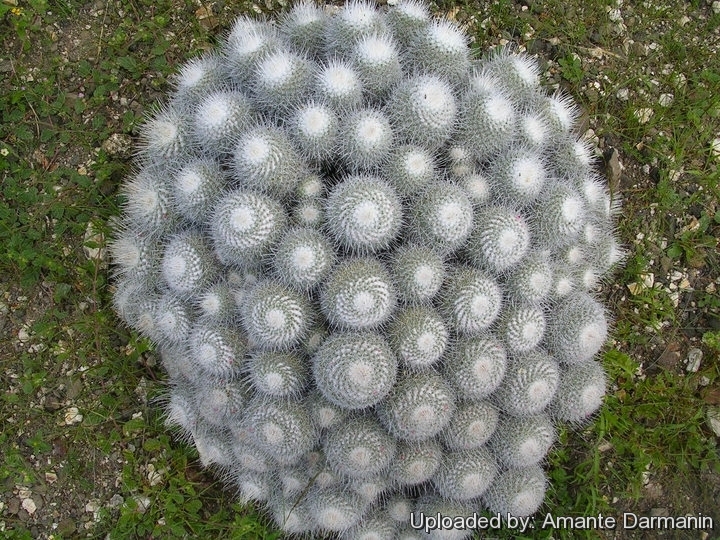
Mammillaria geminispina Photo by: Amante Darmanin
Growing habit at Metztitlan, Hidalgo, Mexico. This Mammillaria gets only better looking with age. It will continue to put on more and more heads, as well as more white cotton topping. The heads form mounds that seem stacked on top of each other.
Origin and Habitat: Guanajuato, Hidalgo, Querétaro, San Luis Potosí and possibly Veracruz. Mexico.
Altitude: 1000 - 1850 metres above sea level.
Habitat and Ecology: This species is found in xerophyllous scrub on calcareous soils on rocky hills, together with Cephalocereus senilisSN|6893]]SN|6893]], Gymnocactus horripilusSN|12124]]SN|12124]], Mammillaria schiedeanaSN|8885]]SN|2251]], Mammillaria wildiiSN|2251]]SN|8885]], Astrophytum ornatumSN|3660]]SN|3660]], Gymnocactus horripilusSN|12124]]SN|12124]], Selenicereus spinulosusSN|8698]]SN|8698]], Ferocactus glaucescensSN|1532]]SN|1532]], Cephalocereus senilisSN|6893]]SN|6893]], Stenocereus dumortieriSN|7942]]SN|7942]], Fouquieria purpusii, Brahea dulcisSN|24746]]SN|24746]], Echeveria coccineaSN|13290]]SN|13290]], Tillandsia grandis, Hechtia podanthaSN|19012]]SN|19012]], Agave strictaSN|208]]SN|568]] and Agave xylonacanthaSN|568]]SN|208]]. It forms colonies. In appropriate habitat the species is abundant. Historically the species was overcollected, however today this threat has been reduced.
Synonyms:
See all synonyms of Mammillaria geminispina
Common Names include:
ENGLISH: Whitey, Twin Spined Cactus, White Cactus
RUSSIAN (Русский): Маммиллярия парноколючковая
SPANISH (Español): Cabeza blanca
UKRAINIAN (Українська): Мамілярія гемініспіна, Мамілярія парноколючкова
Description: Mammillaria geminispinaSN|14012]]SN|14012]] is a highly variable densely spined species. Some cluster aggressively and form 30 to 90 cm large clumps that appear white, while other seem to stay more solitary.
Stem: Short cylindrical, light green whit latex, up to 18 cm high and 8 cm in diameter.
Tubercles: Rounded with latex. The axil is filled by white wool and 10 - 20 long white bristles.
Spines: Spines are variable too, some plants have very short while others have long spines.
Central spines: 2 (to 6) pure white or white with dark tip that protrude far out from the rest, straight or slightly curved, 0,5 to 4 cm long (or more).
Radial spines: 16 to 20 chalky white, interlacing up to 7 mm long.
Flowers: Campanulate, pinkish to carmine red, with darker midveins, to 20 mm long and in diameter usually in a ring in the growth of the previous year but sometime more randomly over the body. If grown from seed, M. geminispina can take seven to eight years before flowering.
Fruits: Red
Seeds: Brown.
Subspecies, varieties, forms and cultivars of plants belonging to the Mammillaria geminispina group
Notes: Mammillaria elegansSN|20850]]SN|13998]] A.P. de Candolle 1828. is a 'nomen confusum' also applied to Mammillaria haageana ssp elegans and referes bolth to M. geminispina with latex in the stem (Subgenus Mammillaria section Hydrochylus series supertextae ) and to Mammillaria haageanaSN|13998]]SN|20850]], without latex in the stem ( Subgenus Mammillaria, section Galactophylous, series Leucocephale )
Bibliography: Major references and further lectures.
1) Robert T. Craig “The Mammillaria handbook: with descriptions, illustrations, and key to the species of the genus Mammillaria of the Cactaceae” E P Publishing, 1945
2) John Pilbeam “Mammillaria The Cactus File Handbook” Cirio Pub. Services, 01/Dec/1999
3) Edward Anderson “The Cactus family” Timber Press, Incorporated, 2001
4) James Cullen, Sabina G. Knees, H. Suzanne Cubey "The European Garden Flora Flowering Plants: A Manual for the Identification of Plants Cultivated in Europe, Both Out-of-Doors and Under Glass" Cambridge University Press, 11/Aug/2011
5) David R Hunt; Nigel P Taylor; Graham Charles; International Cactaceae Systematics Group. "The New Cactus Lexicon" dh books, 2006
6) Gómez-Hinostrosa, C., Sánchez , E., Guadalupe Martínez, J. & Bárcenas Luna, R. 2013. Mammillaria geminispina. In: IUCN 2013. "IUCN Red List of Threatened Species". Version 2013.2. <www.iucnredlist.org>. Downloaded on 16 March 2014.
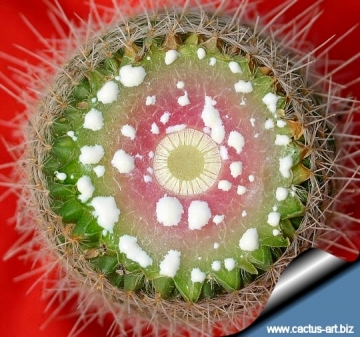 Mammillaria geminispina Photo by: Cactus Art
Mammillaria geminispina Photo by: Cactus Art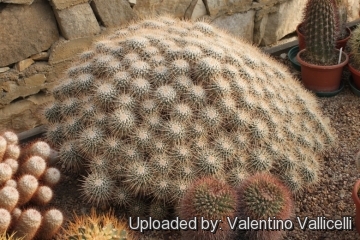 Mammillaria geminispina Photo by: Valentino Vallicelli
Mammillaria geminispina Photo by: Valentino Vallicelli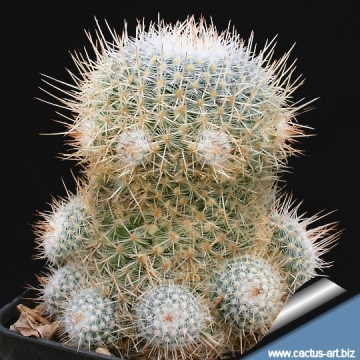 Mammillaria geminispina Photo by: Cactus Art
Mammillaria geminispina Photo by: Cactus Art Mammillaria geminispina, in habitat at Metztitlan, Hidalgo. Photo by: Amante Darmanin
Mammillaria geminispina, in habitat at Metztitlan, Hidalgo. Photo by: Amante Darmanin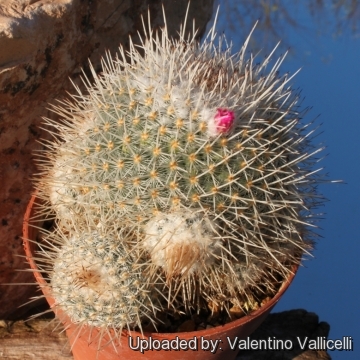 Mammillaria geminispina Photo by: Valentino Vallicelli
Mammillaria geminispina Photo by: Valentino Vallicelli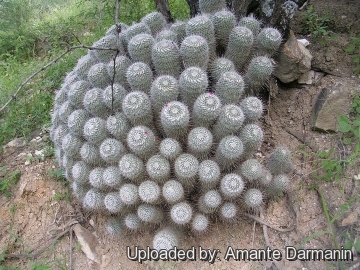 Mammillaria geminispina, in habitat at Metztitlan, Hidalgo. Photo by: Amante Darmanin
Mammillaria geminispina, in habitat at Metztitlan, Hidalgo. Photo by: Amante DarmaninCultivation and Propagation: It is a fairly easy plant to grow, don't requires any special treatment, but need as much light as possible without burning the plant to encourage the heaviest spine formation, if kept too dark it may become overly lush and greener and could be prone to rotting due to over watering.
During the summer it is best to keep the plants outside where the temperature can rise to over 30 C with no harm to the plant. Furnish good drainage and use a an open and free draining mineral compost that allows therefore roots to breath. They like only a short winter's rest and should be kept almost completely dry during the winter months, If the soil is allowed to be dry for too long root loss could follow but equally the same result would occur if the plants are both wet and cold. From March onwards the plant will begin to grow and watering should be increased gradually until late May when the plant should be in full growth.
Water regularly during the summer so long as the plant pot is allowed to drain and not sit in a tray of water. During hot weather you may need to water the plants more frequently so long as the plant is actively growing. From late September watering should be reduced to force the plant to go in to a state of semi dormancy, by October you should be back in to the winter watering regime.
Feeding may not be necessary at all if the compost is fresh then, feed in summer only if the plant hasn't been repotted recently. Do not feed the plants from September onwards as this can cause lush growth which can be fatal during the darker cold months. Grown specimens resist to -4°C for a short time, but it is best to keep above 0° C to avoid ugly spots on the plant epidermis.
Propagation: Seeds or by stem cuttings from adult plants.
















